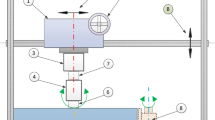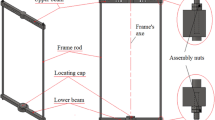Abstract
To optimize the design of force dynamometers incorporating octagonal ring elements it is important to be able to predict the dynamometer sensitivities. Previous methods relying on thin ring theory have been inadequate because octagonal rings often have a thickness which cannot be considered thin and, further, the thickness is not uniform. In this paper, empirical equations that describe the deflections, strains and von Mises stresses of individual octagonal rings due to radial, tangential and axial forces are developed using finite-element models. These models are loaded and constrained to simulate the most common uses of octagonal rings in force dynamometers. A nonlinear regression routine is used to develop the above equations from the data given by the finite-element analysis. The performance of these equations is evaluated and presented in tabular form. A procedure is also outlined to describe the use of these equations in the design of six-load-component dynamometers.
Similar content being viewed by others
Abbreviations
- A, B, C, D, A′, B′, C′, D′:
-
strain-gage locations
- C ii :
-
proportionality constants relating total voltage signals to loads (N/V or Nm/V)
- d r, dt, da :
-
radial, tangenitial and axial deflections respectively of the top surface of ring (m)
- e A, eB, eC, eD :
-
strain at subscripted strain-gage location (μstrain)
- E :
-
Young's modulus (Pa)
- E1, … E6 :
-
constants used in developing the equations of deflection of axially loaded octagonal rings
- f a.009 :
-
function in axial deflection equation forr=0.009 m
- f d, fe :
-
functions in deflection and strain equations respectively
- f VMSr, FVMSt, fVMSa :
-
functions describing maximum von Mises stress due to individual loadsF r, Ft andF a respectively
- F r, Ft, Fa :
-
radial, tangential and axial forces respectively acting on top of ring (N)
- F x, Fy, Fz :
-
forces on a dynamometer (N)
- M x, My, Mz :
-
moments on a dynamometer (Nm)
- P1, P2, P3 :
-
constants used in developing the equations for tangential strain-gage location
- r, t, b :
-
radius, thickness and base width respectively for octagonal ring (m)
- t *, b* :
-
factors used in the axial deflection and von Mises stress equations
- V in :
-
input excitation to Wheatstone bridges (V)
- V r, Vt :
-
voltage outputs from Wheatstone bridges corresponding toF r andF t respectively (V)
- V ri, Vti :
-
voltage from bridge on octagonal ringi corresponding toF r andF t respectively (V)
- VMS:
-
maximum von Mises stress (Pa)
- x, y, z :
-
denoted coordinate system for dynamometer
- l 1,l2 :
-
width and length respectively of dynamometer (m)
- θ:
-
angular location of point of zero strain due to radial loading measured from the horizontal line passing through the center of an octagonal ring (degrees)
References
Beyer, W.H., CRC Standard Mathematical Tables, 26th Ed., CRC Press, Inc., Boca Raton, FL (1981).
DeSalvo, G.J. and Swanson, J.A., ANSYS: Engineering Analysis System User's Manual, Swanson Analysis Systems, Houston, PA, I and II (1985).
Dubois, M., “Six-component Strain-gage Balances for Large Wind Tunnels,”Experimental Mechanics,21 (11),401–407 (1981).
Ewald, B., “The Development of Electron Beam Welded Strain Gaged Wind Tunnel Balances,”J. Aircraft,16 (5),349–352 (1979).
Hull, M.L. andDavis, R.R., “Measurement of Pedal Loading in Bicycling: I. Instrumentation,”J. Biomechanics,14 (12),843–855 (1981).
Ito, S., Sakai, S. andIshikawa, M., “A Study on a Two Dimensional Dynamometer for Surface Grinding,”Bul., Jap. Soc. of Prec. Eng.,14 (1),25–30 (1980).
Perry, C.C. andLissner H.R., The Strain Gage Primer, 2nd Ed., McGraw-Hill Book Co., Inc., New York (1962).
SAS, SAS Institute, Inc., Box 8000, Gary, NC, 27511-8000 (1985).
Shaw, M.C., Metal Cutting Principles, Clarendon Press, Oxford (1984).
Tani, Y., Hatamura, Y. andNagao, T., “Development of Small Three Component Dynamometer for Cutting Force Measurement,”Bul. Jap. Soc. of Mech. Eng.,26 (214),650–658 (1983).
Wunderly, G. andHull, M.L., “A New Electromechanical Binding/Dynamometer for Actively Controlled Snow Ski Binding Systems,”Skiing Trauma and Safety, STP 938, Amer. Soc. for Test. and Mat., Philadelphia, 249–259 (1985).
Kroencke, M. andHull, M.L., “Computer-Aided Design of Multi-Load Component Dynamometers Incorporating Octagonal Strain Rings,”Computers in Engineering 1988, Amer. Soc. of Mech. Eng., New York,3,185–195 (1988).
Author information
Authors and Affiliations
Rights and permissions
About this article
Cite this article
Kroencke, M., Hull, M.L. A method for designing multiload component dynamometers incorporating octagonal strain rings. Experimental Mechanics 29, 195–204 (1989). https://doi.org/10.1007/BF02321375
Received:
Revised:
Issue Date:
DOI: https://doi.org/10.1007/BF02321375




